A Distributed Continua AHD System with ZigBee/PAN-IF Gateway and Continua QoS Control Mechanism
Abstract
:1. Introduction
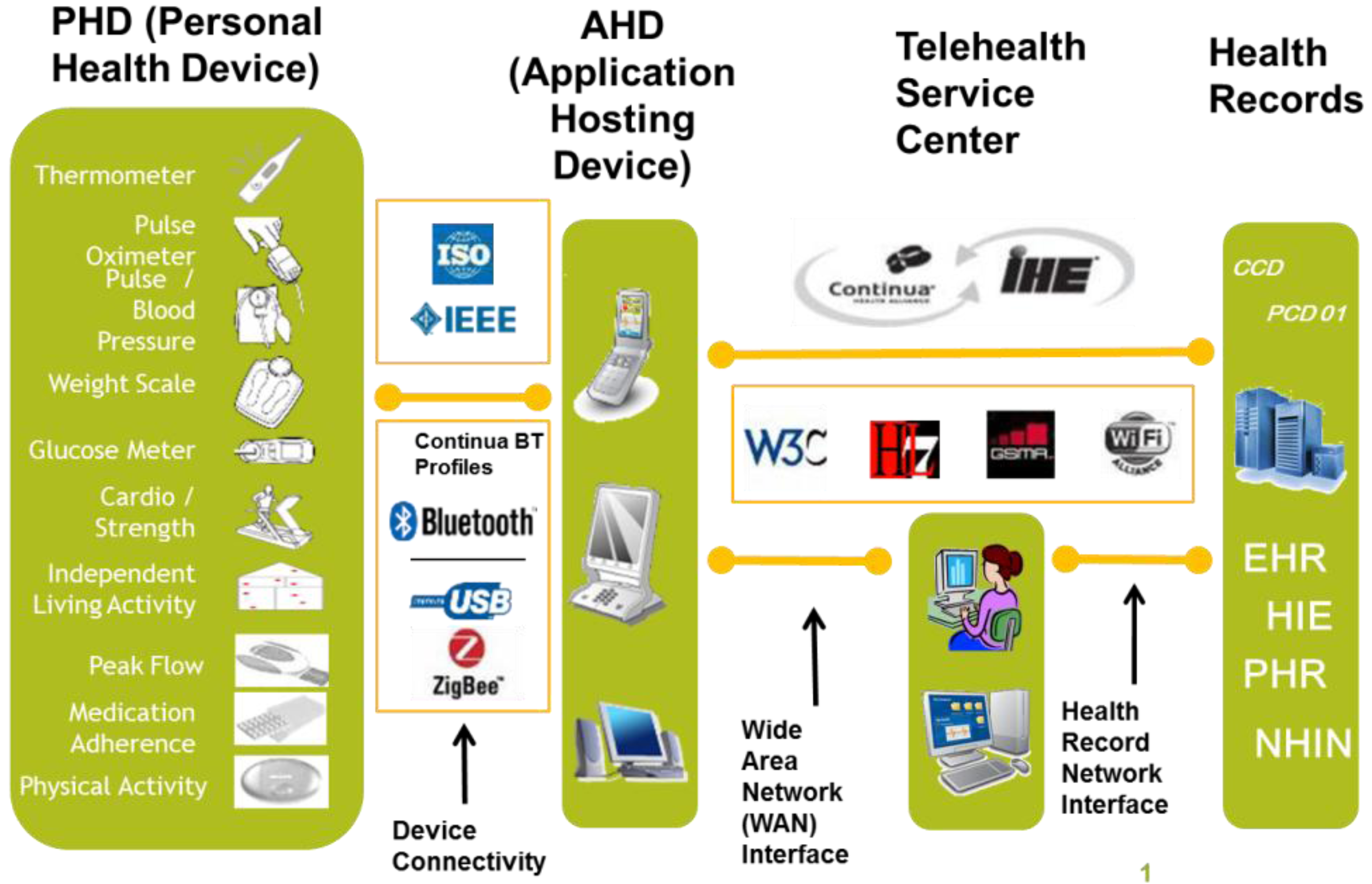
2. Related Work
2.1. Gateway System Architecture
2.2. QoS Control for 802.15.4 MAC Layer
3. Distributed Continua AHD System and QoS Mechanism
3.1. Distributed Continua AHD System
- a. Original sequence: Continua AHD: IEEE 11073 PHD Stack → (call) Continua AHD: PAN IF Transport API
- b. Coverted sequence: Continua AHD Host: IEEE 11073 PHD Stack → (call) Continua AHD Host: Virtual PAN IF Transport API → ZigBee/802.15.4 network → Continua AHD Gateway: PAN IF Transport Stack
- a. Original sequence: Continua AHD: PAN IF Transport Stack → (call) Continua AHD: IEEE 11073 PHD API
- b. Converted sequence: Continua AHD Gateway: PAN IF Transport Stack → (call) Continua AHD Gateway: Virtual IEEE 11073 PHD API → ZigBee/802.15.4 network → Continua AHD Host: IEEE 11073 PHD Stack.

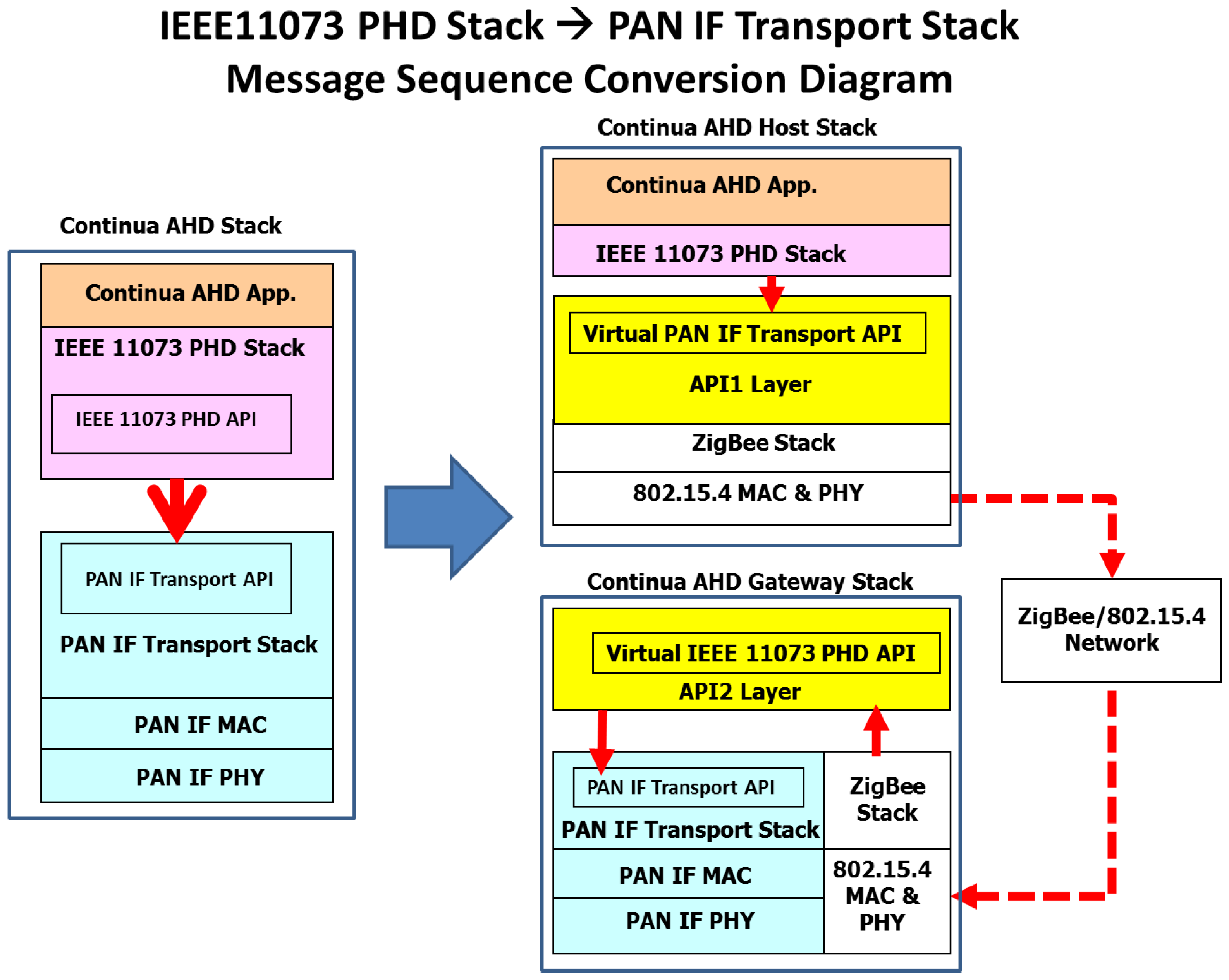
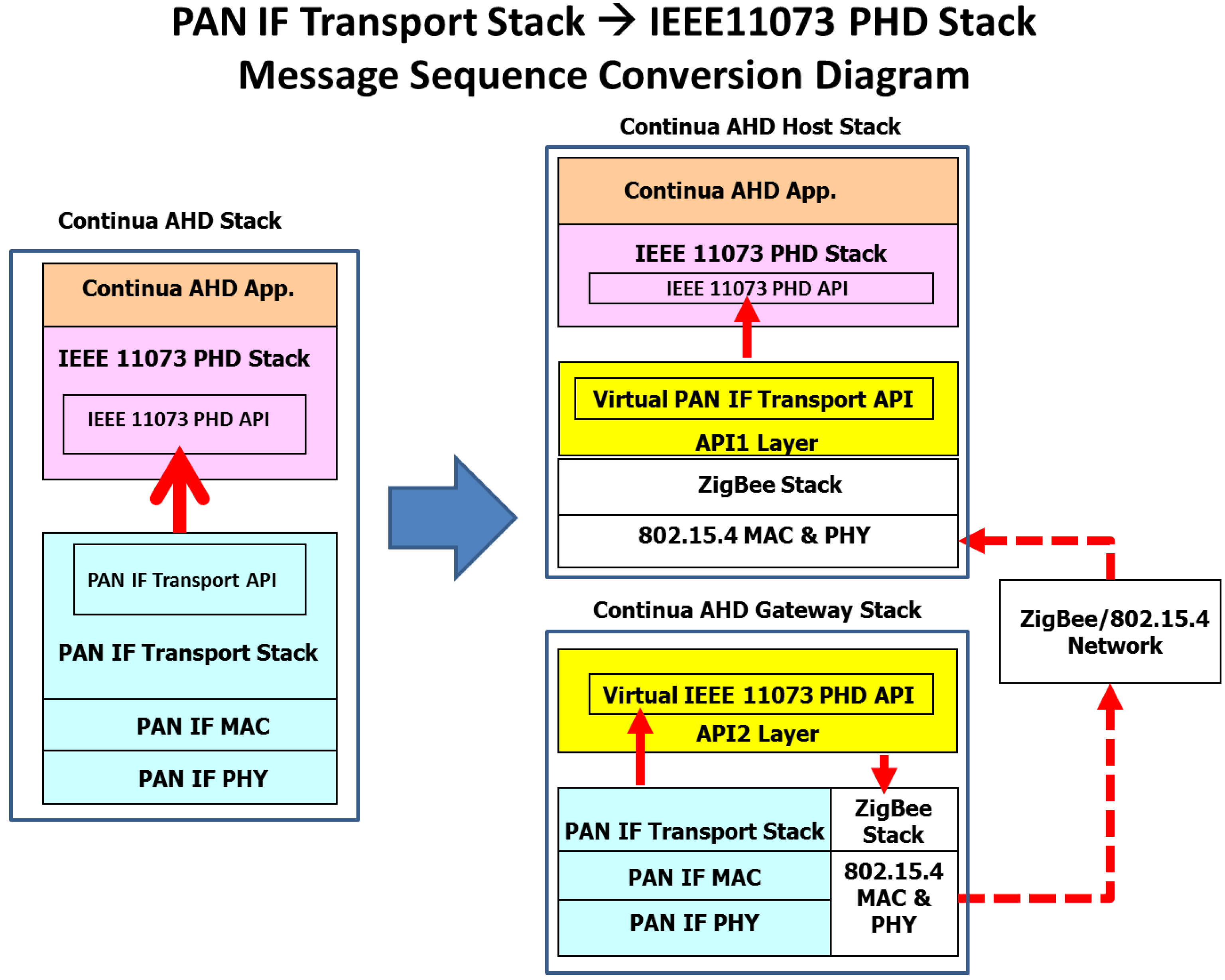
3.2. QoS Controller Design
- 1. QoS control mechanism in API1 and API2 stacks: Automatically monitors message and records connection information. Maps the message type and connection information to a corresponding < Priority, APS ACK, MAC Retries > QoS Control Parameter, where APS ACK and MAC Retries are QoS Control parameters for the stacks at lower layers of ZigBee/802.15.4 network. The message is transmitted based on the value of QoS Control parameters.
- 2. QoS control mechanism in ZigBee layer: To comply with the standard set for Continua sensor-LAN IF, we adopt the APS ACK (Application Sub-layer Acknowledge) mechanism in ZigBee 2007 to support Reliability vector.
- 3. QoS control mechanism in 802.15.4 MAC layer: It has been shown in article [7] that QoS can be achieved with some modified mechanisms at the 802.15.4 MAC layer while maintaining backward compatibility. To meet the End-to-End QoS requirements, we can further modify these mechanisms in supporting the prioritized transmitting service at MAC layer and the proper control of MAC Retries parameters.
| Continua QoS bin< Reliability ∙ Latency > | Message Type | QoS Control Parameters < Priority ∙ APS ACK ∙ MAC Retries > |
|---|---|---|
| < Best ∙ Very High > | =6: | < 5:Low ∙ 1:ACK ∙ 3 > |
| • Print, transfer or exchange of summaries, reports or histories | ||
| < Best ∙ High > | =5: | < 4:Medium ∙ 1:ACK ∙ 3 > |
| •Both physiological driven alarms and equipment issued alarms | ||
| < Best ∙ Medium > | =4: | < 3:High ∙ 1:ACK ∙ 3 > |
| • Aka get/set device parameters; aka events and/or notifications; aka request/response | ||
| • Control/status of both physiological and equipment functionality | ||
| < Better ∙ Medium > | =3: | < 3:High ∙ 1:ACK ∙ 3 > |
| • measured parameter (Blood Pressure, SpO2 (blood oxygen saturation), Heart Rate) | ||
| < Good ∙ Medium > | =2: | < 2:VeryHigh ∙ 0:NO-ACK ∙ 5 > |
| • waveform information (ex:ECG wave data) | ||
| < Good ∙ Low > | =1 : NA. | < 1:Highest ∙ 0:NO-ACK ∙ 5 > |
3.2.1. QoS Controller Design for API1 & API2 Module
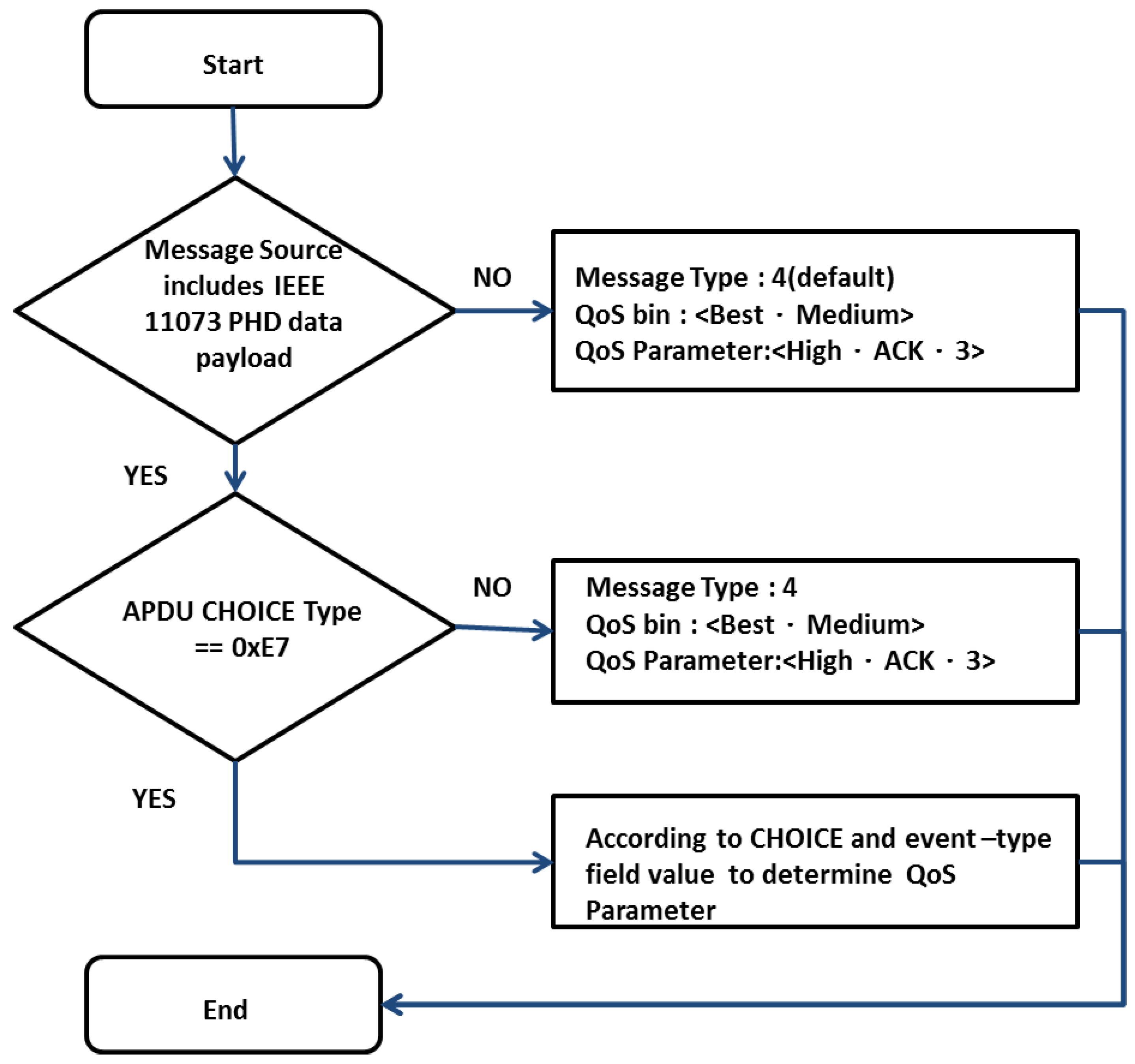
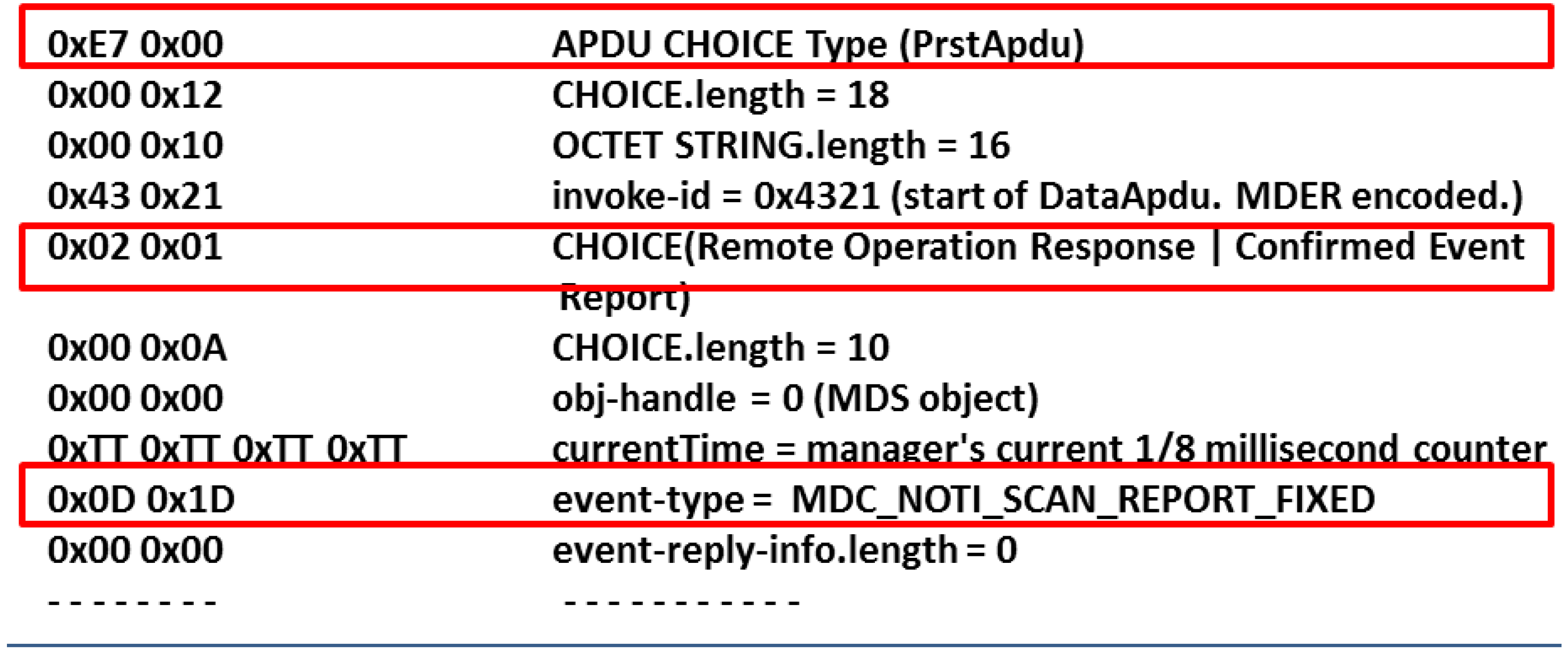
- 1. A BT MDL connection with label of # 1MDL_ID, Message Type = 3 indicates transmission of biomedical measurements like blood pressure/blood glucose/heart rate, QoS Parameters = < 3 ∙ APS ACK ∙3 >.
- 2. An MDL connection with label of # 2MDL_ID, Message Type = 2 indicates transmission of ECG waveform data, QoS Parameters = < 2 ∙ PS NO-ACK ∙ 5 >.
- 3. An MDL connection with label of # 3MDL_ID, Message Type = 3 indicates transmission of biomedical measurements like blood pressure/blood glucose/heart rate, QoS Parameters = < 3 ∙ APS ACK ∙ 3 >.
| Loc_MDL_ID | Message Type | Priority | APS ACK | MAC Retries |
|---|---|---|---|---|
| #1_MDL_ID | 3 | 3 (HIGH) | 1 (ACK) | 3 (default) |
| #2_MDL_ID | 2 | 2 (VERY HIGH) | 0 (NO-ACK) | 5 |
| #3_MDL_ID | 3 | 3 (HIGH) | 1 (ACK) | 3 (default) |
| ⋮ | ⋮ | ⋮ | ⋮ | ⋮ |
| USB PHDC pipe QoS bin [Delay Reliability] | Continua QoS bin < Reliability Delay > |
|---|---|
| [very high best] | < best ∙ very high > |
| [high best] | < best ∙ high > |
| [medium best] | < best ∙ medium > |
| [medium better] | < better ∙ medium > |
| [medium good] | < good ∙ medium > |
| [low good] | < good ∙ low > |
3.2.2. QoS Control Parameters Supported By ZigBee/802.15.4
- 2. Instead of using Access Category method in article [7], we expand it directly to five Priority Queues in a direct mapping to the five Priorities.
- 3. For the transmission of Best/Better Reliability type of message where there is APS ACK parameter and Resend support mechanism, we set its macMaxFrameRetries = 3 (default value). However, in order to improve the successful transmission rate for Good Reliability type of message without APS ACK parameter support, we set its macMaxFrameRetries = 5.

4. Conclusions
Acknowledgments
Conflict of Interest
References
- Continua Health Alliance. Available online: http://www.continuaalliance.org/index.html (accessed on 5 June 2012).
- ZigBee Alliance. Available online: http://www.zigbee.org (accessed on 5 June 2012).
- Osborn, W.R.; Bennett, J.W. Zigbee/IP Gateway. U.S. Patent 8,149,849 B2, 3 April 2012. [Google Scholar]
- Kim, T.; Lee, D.; Ahn, J.; Choi, S. Priority Toning Strategy for Fast Emergency Notification in IEEE 802.15.4 LR-WPAN. In Proceedings of the 15th Joint Conference on Communications & Information, Daegu, Korea, 27-29 April 2005; pp. 875–882.
- Pang, A.-C.; Tseng, H.-W. Dynamic Backoff for Wireless Personal Networks. In Proceedings of IEEE GLOBECOM 2004, Dallas, TX, USA, 29 November-3 December 2004; pp. 1580–1584.
- Koubaa, A.; Alves, M.; Nefzi, B.; Song, Y. Improving the IEEE 802.15.4 Slotted CSMA/CA MAC for Time-Critical Events in Wireless Sensor Networks. In Proceedings of the Workshop on Real-Time Networks, Torino, Italy, July 2006.
- Garcia, J.J.; Falck, T. Quality of Service for IEEE 802.15.4-Based Wireless Body Sensor Networks. In Proceedings of 3rd International Conference on Pervasive Computing Technologies for Healthcare, London, UK, 1-3 April 2009; pp. 1–6.
© 2012 by the authors; licensee MDPI, Basel, Switzerland. This article is an open-access article distributed under the terms and conditions of the Creative Commons Attribution license (http://creativecommons.org/licenses/by/3.0/).
Share and Cite
Huang, Y.-S.; Shih, M.; Shau, Y.-W.; Lin, W.T. A Distributed Continua AHD System with ZigBee/PAN-IF Gateway and Continua QoS Control Mechanism. J. Sens. Actuator Netw. 2012, 1, 97-110. https://doi.org/10.3390/jsan1020097
Huang Y-S, Shih M, Shau Y-W, Lin WT. A Distributed Continua AHD System with ZigBee/PAN-IF Gateway and Continua QoS Control Mechanism. Journal of Sensor and Actuator Networks. 2012; 1(2):97-110. https://doi.org/10.3390/jsan1020097
Chicago/Turabian StyleHuang, Yung-Shun, Min Shih, Yio-Wha Shau, and William T. Lin. 2012. "A Distributed Continua AHD System with ZigBee/PAN-IF Gateway and Continua QoS Control Mechanism" Journal of Sensor and Actuator Networks 1, no. 2: 97-110. https://doi.org/10.3390/jsan1020097




